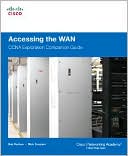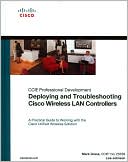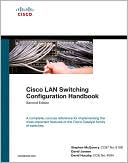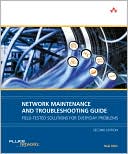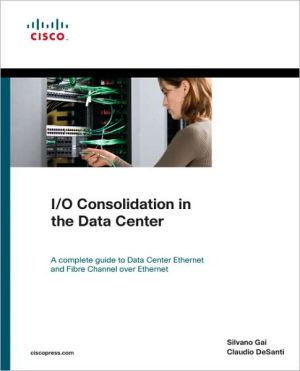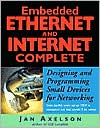Wireless LAN Standards and Applications
If you're an engineer involved in developing wireless LAN systems, this valuable book will give you a practical understanding of the latest wireless LAN standards and their implementation. The book clearly explains the two principal standards, IEEE 802.11 and IrDA, plus the HIPERLAN standard, and explores their real-world applications through commercially available equipment. Specific scenarios explain how WLAN systems can be built and integrated with cabled systems.\ \ \...
Search in google:
Exceptionally valuable to engineers involved in developing wireless LAN (WLAN) systems, this practical reference offers a thorough understanding of the latest WLAN standards and their implementation. Wireless LAN Standards and Applications clearly explains the two principal standards, IEEE 802.11 and IrDA, plus the HIPERLAN standard, and explores their real-world applications through commercially available equipment. Moreover, the book presents specific scenarios that explain how WLAN systems can be built and integrated with cabled systems. Over 80 illustrations help clarify major topics throughout. Booknews One Cuban and seven Spanish scientists and engineers provide an overview of wireless system standards, emphasizing the new environments in which wireless systems are gaining importance, among them the home, office, transportation, and personal communication. They also provide web sites for the main regulation and standardization organizations, and for the technological alliances that are driving the evolution of wireless technology. The standards they cover are the IrDA, the IEEE 802.11, and the HIPERLAN. They also discuss application scenarios and upcoming standards and future trends. Annotation c. Book News, Inc., Portland, OR (booknews.com)
Chapter 6: Upcoming Standards and Future Trends\ J. M. Riera and R. Peréz-Jiménez\ Contents\ \ 6.1 Introduction: Is the future wireless?\ 6.2 The evolution of HIPERLAN\ 6.3 The evolution of IEEE 802.11\ 6.4 Forthcoming IR standards\ 6.5 Other RF standards: DECT, Bluetooth, WATM, HomeRF, etc.\ 6.6 Conclusions\ \ 6.1 Introduction: Is the future wireless?\ In the last decade, a large number of standardization bodies, official or industrial, have been busy working on the definition of wireless (RF and IR) systems for applications ranging from high-speed kilometer-range wireless access (i.e., local multipoint distribution system (LMDS)) to low-speed very- short-range device interconnection (i.e., the original IrDA). When considering the forces that drive this work the world over, some important points must be taken into account: \ \ In the alternative between standards and proprietary systems, the former seems to be winning in all moderate- to large-size markets because of the proven effectiveness of economies of scale in reducing manufacturing costs. Besides, users are demanding interoperability to be free to choose equipment from different manufacturers. The global successes of standards such as GSM for mobile communications or Ethernet in the LAN market are pumping the standardization works.\ The official standardization bodies are seen as slow by some parties, due to the fact that they are subject to pressures from different agents. Some industrial corporations have formed alliances to define specifications intended to become industrial de facto standards. IrDA or Bluetooth are good examples of this. This does not exclude the fact that some industrial standards may become official standards in the future.\ The information society is bringing about huge interchanges of data that must be carried to the user in very different situations for a wide range of applications. The flexibility provided by wireless links can be a determinant in the rapid growth of many applications.\ The success of mobile communications, with mobile phones approaching or surpassing the number of fixed phones in many countries, will almost certainly be followed by the success of mobile data communications.\ Cabled communications involve the need for infrastructure that is hard to install, and can be very inconvenient. For example, the cost of cabling cities is high, and the process takes many years. In domestic/business premises, the cost of the cables is not large, but the user is fixed to the end of the cable, and there is some burden in the need to have cables all around. A computer without the keyboard, mouse, and printer cables (which is technically feasible today) is not only much cleaner and more elegant, it is also easier to install and transport from one place to another and more comfortable to use as the different elements are not mechanically linked.\ \ However, cabled networks are usually cheaper, which is largely due to economies of scale. They can also provide very high bandwidths, in excess of what can be reasonably provided by wireless networks. New applications such as the family of xDSL [1] or cable modem are the keys to the future of cable communications in access networks.\ A wireless future can be envisioned with the following features:\ \ Telephony will be mostly mobile, with phone numbers associated with people, instead of places. The number of mobile phones will be on the order of 90% of the population able to use it (every- body over six, with the possible exception of disabled or very old people).\ Fixed access, which will still be necessary for the home and offices, will be provided by microwave and millimeter-wave links, with point-to-multipoint standards (like LMDs), or, in the case of high bandwidth users, point-to-point links.\ Inside the home or office, devices will communicate to each other with some of the short-range technologies (WLAN or others) that are currently being defined.\ Internet access, or data access in general, will be provided at fixed points by the mentioned fixed access technologies, and by third and future generations of mobile communications. Very-high- speed broadcast can be obtained from satellites (with DVB transmission) and future stratospheric platforms. Entertainment, such as TV, will eventually become indistinguishable from Internet access.\ \ This wireless future is a maybe, as cable communications remain very active, and the scarcity of the radio spectrum will always remain a hard limit to the capacity that can be carried. However, many of these features are present today or will arise in the near future.\ This book focuses on WLAN standards. The rest of this chapter discusses the evolution of the wireless standards discussed in previous chapters (IEEE 802.11, HIPERLAN, and IrDA), and presents new wireless standards that can provide LAN services but that have been defined for a broader range of applications. This is indicative of a developing trend: standards that cover multiple applications, providing a link to communication terminals while offering enough flexibility to be employed in a variety of scenarios.\ Another important trend that is worth mentioning is the evolutionary nature of current standards. They are not fixed iionce and for alllc but are being updated again and again to add new features or to find new applications. The current speed of technological innovation is determinant on this fact. On many occasions, the new version of a standard can be implemented with the same hardware, by means of updating the software.\ 6.2 The evolution of HIPERLAN\ Chapter 4 extensively described the HIPERLAN/1 standard and introduced HIPERLAN/2 and the other ETSI BRAN standards (HIPERACCESS and HIPERLINK). This chapter discusses only the current state of HIPERLAN/1 and HIPERLAN/2, as HIPERACCESS and HIPERLINK are not WLAN, although they may complement one. The HIPERLAN/1 specifications are finished, and the HIPERLAN/2 specifications are currently quite advanced. HIPERACCESS and HIPERLINK specifications are still in the early phase.\ Some manufacturers, with the purpose of accelerating the adoption of HIPERLAN/1-based products worldwide, have formed the HIPERLAN Alliance. Market promotion, spectrum lobbying, and cooperation with other standardization bodies are among the objectives of the HIPERLAN Alliance. More information can be found in [2]. To our knowledge, there are no HIPERLAN products on the market at the moment, but they are expected to appear very soon.\ HIPERLAN/2, originally based on WATM, has extended its scope for providing WLAN services and for interacting with core networks of different kinds, such as ATM, IP, and UMTS.\ Figure 6.1 shows the reference model for HIPERLAN/2. A convergence layer provides connectivity with the core network. Thus, the standard is open in that it can use other networks in the future, with the only specification being that of the corresponding convergence layer. A good description of this standard can be found in [3], a document that also includes references to the related ETSI technical documents.\ The most important distinguishing characteristic of HIPERLAN/1 is its centralized MAC, which supports QoS functions. HIPERLAN/2 can operate in a centralized mode, which allows the implementation of radio access to a fixed point. Thus, a network can be implemented to cover entire buildings through the deployment of APs in a cellular structure. It can also operate in ad hoc networks, without the need for APs, but in this case one of the devices must operate as a central controller. The central controller can be any of the devices in the network, and can change if, for example, the current central controller leaves the net....
PrefaceAcknowledgmentsIntroduction1The IrDA Standard9Introduction to the IrDA - General description9Physical layer (SIR)13Serial infrared link access protocol (IrLAP)22IRDA link management protocol (IrLMP)28IRDA transport protocol: TinyTP35LAN access extensions for link management protocol: IrLAN38The IEEE 802.11 Standard45Introduction to IEEE 802.11: General description45Medium access control (MAC) for the IEEE 802.11 wireless LANs (WLANs)47Physical layer for IEEE 802.11 wireless LANs: Radio Systems69Physical layer for IEEE 802.11 wireless LANS: Infrared systems96Conclusions and applications104The HIPERLAN Standard109Introduction: Terminology109Physical layer (PHY)113HIPERLAN channel access control (CAC)121HIPERLAN median access control (MAC)131Conclusions on HIPERLAN type 1146Future BRAN standards147Application Scenarios151The application scenarios152Wireless LAN technologies and products161Conclusions176Upcoming Standards and Future Trends183Introduction: Is the future wireless?183The evolution of HIPERLAN186The evolution of IEEE 802.11188Forthcoming IR standards190Other RF standards: DECT, Bluetooth, WATM, HomeRF, etc200Conclusions209Glossary213About the Author223Index225
\ BooknewsOne Cuban and seven Spanish scientists and engineers provide an overview of wireless system standards, emphasizing the new environments in which wireless systems are gaining importance, among them the home, office, transportation, and personal communication. They also provide web sites for the main regulation and standardization organizations, and for the technological alliances that are driving the evolution of wireless technology. The standards they cover are the IrDA, the IEEE 802.11, and the HIPERLAN. They also discuss application scenarios and upcoming standards and future trends. Annotation c. Book News, Inc., Portland, OR (booknews.com)\ \

